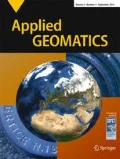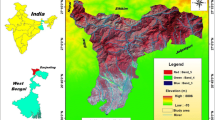Abstract
Geomatics was used in this paper to provide efficient tools to create maps and to perform all the necessary analysis about crops (computation of areas, discrimination of crop types etc.) in Mujib Basin (MB), in a timely and cost-effective manner which can’t be delivered using the conventional surveying technology. The use of these techniques allowed the identification and the delineation of agricultural parcels and then the computation of their areas in this basin. This leads to the production of a digital crop map. The obtained crop map beside FAO and climatic data permitted the evaluation of water requirements for crops during the intended period. This study showed the efficiency of geomatics techniques to reveal the illegal use of the underground water resources in comparing with the well production in this basin and to estimate the water requirement to irrigate all parcels during the year 2015. Significant difference between well production and water requirements for the parcels irrigated from underground water is found. This proves the use of illegal water resources for example by digging wells without permission or taking water from main pipelines before metring. This metring helps the control of the consumed water from underground reservoirs.







Similar content being viewed by others
References
Al Rawashdeh SB (2012) Assessment of change detection method based on normalized vegetation index in environmental studies. Int J Appl Sci Eng 10(2):89–97
Al Rawashdeh SB (2007) Use of GIS and remote sensing for the detection of saline areas, International Conference Ascee2 – EGYPT-Ain Shams University-Faculty of Engineering
Al Rawashdeh SB (2011) Evaluation of the differencing pixel by pixel change detection method in mapping irrigated areas in dry zones. Int J Remote Sens 32(8):2173–2184
Allen RG, Pereira LA, Raes D, Smith M (1998) Crop evapotranspiration. FAO irrigation and drainage paper 56. Rome: FAO, 293 p
Bastiaanssen W (2015) Satellite-based estimation of evapotranspiration, soil moisture and biomass production for two irrigated areas in Jordan. A report for the Ministry of Water and Irrigation, Amman, Jordan
Hamdi M, Abu-Allaban M, Al-Shayeb A, Jaber M, Momani N (2009) Climate change in Jordan: a comprehensive examination approach. Am J Environ Sci 5(1):58–68 ISSN 1553-345X
Mannini P, Genoveski R, Leterrio T (2013) IRRENT: large scale DSS application for on-farmbirrigation scheduling. Procedia Environ Sci 19:823–829
Milano M, Ruelland DS, Dezetter A, Fabre J, Serat E, Fritsch M, Ardoin-bardin S, Thiret G (2013) Current state of Mediterranean water resources and future trends under climatic and anthropogenic changes. Hydrol Sci J 58:498–518
Ministry of Agriculture-Jordan, Annual report of 2014, (2014)
Ministry of Water and Irrigation-Jordan, Rainfall and climatic data, 2015
Rinaldi M, He Z (2014) Decision support systems to manage irrigation in agriculture. In: Sparks DL (ed) Advances in agronomy, vol 123. Academic Press, Barlintons, pp 229–279
Shawash S. (2015) Actual crop evapotranspiration estimation using SEBAL MODEL, A report for regional coordination on improved water resources management and capacity building, Ministry of Water and Irrigation, Amman, Jordan
Terasa R, Allen R, Tasumi M (2013) Estimation of evapotranspiration along the middle Rio Grande of New Mexico using Modis and Landsat imagery with the metric Model. Remote Sen J 2072-4282(5):5397–5423. https://doi.org/10.3390/rs5105397
Author information
Authors and Affiliations
Corresponding author
Rights and permissions
About this article
Cite this article
Al Rawashdeh, S.B. The use of geomatics techniques to evaluate crop water requirement in Mujib Basin. Appl Geomat 11, 177–185 (2019). https://doi.org/10.1007/s12518-018-0250-2
Received:
Accepted:
Published:
Issue Date:
DOI: https://doi.org/10.1007/s12518-018-0250-2




